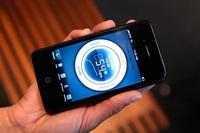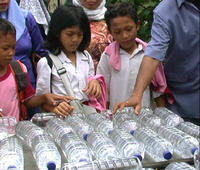-
Electronic cotton: smart cloths made from conductive cotton fiber
The latest breakthrough in cotton fiber research may soon make possible hospital gowns that monitor medical patients and jerseys that test athletic performance
-
-
Lawmakers seek to protect NY’s growing nanotech industry from terrorists
Last week during a Senate Judiciary Committee hearing, Senator Charles Schumer (D – New York) strongly urged DHS Secretary Janet Napolitano to secure New York’s growing nanotechnology industry against a Mexican terrorist group that has attacked nanotechnology firms around the world
-
-
Paper-based wireless sensor detects explosive devices
Researchers at the Georgia Institute of Technology have developed a prototype wireless sensor capable of detecting trace amounts of a key ingredient found in many explosives; the device, which employs carbon nanotubes and is printed on paper or paper-like material using standard inkjet technology, could be deployed in large numbers to alert authorities to the presence of explosives, such as improvised explosive devices (IEDs)
-
-
OmniTouch turns any surface into a touch screen

Researchers at Microsoft and Carnegie Mellon have created a shoulder-mounted device that can turn virtually any surface into an interactive touch screen; with OmniTouch users can now use walls or even the palm of their hands to control their smartphones
-
-
$35 tablet runs on three watts of power

Developers are now ready to ramp up production on an ultra-low power $35 tablet device after a year of testing in a remote Indian village
-
-
Laser keeps an eye for spoiled food

Minced meat, bread, fruit juice, and many other foods are packaged in a protective gas which extends their shelf life; there is currently no good method to check whether the packaging has the correct gas content — and thus, whether the content is spoiled or not; researchers have developed a new laser instrument which could solve the problem
-
-
Also noted
Radar seeing through walls | Computer virus did not target US drone fleet: general | Salmon-Killing Virus Seen for First Time in the Wild on the Pacific Coast | Irvine Sensors Signs Definitive Agreement to Sell Thermal Imaging Business | SAIC Partners With McAfee to Offer Enterprise Ready Protection From Zero Day and Reconnaissance Attacks
-
-
Software restricts access to sensitive to specific locations
Researchers have created software to remotely put smart phones under lockdown — an innovation that could aid labs doing sensitive research, secure government and military facilities, and keepers of medical records
-
-
Global Security Challenge grand final 24-25 October
Global Security Challenge grand final will be held in London 24-25 October; six start-ups and six SMEs will compete for a prize fund of $500,000
-
-
Robotic car allows drivers to work while driving

The overall cost of road congestion in the United Kingdom to business is likely to rise to £23-24 billion a year within the next fifteen years; increasing public transport capacity may help, but experts believe that, with people unwilling to give up cars, the solution is autonomous vehicles: they make road journeys safer, more efficient, and allow people to do work while on their way to the office
-
-
Mobile consumer devices transmit vital signs

Researchers turn a smart phone into a medical monitor; an app for smart phones, and eventually tablet devices, is turning these mobile devices into sophisticated medical monitors able to capture and transmit vital physiological data
-
-
Teaching sensors to think for themselves
There is a major problem with sensors: data overload; as sensors gather more and more information, it has become increasingly difficult for human users to separate out what is relevant from what is not; two U Vermont researchers received a grant from DARPA to teach sensors what to look for — and what not to look for
-
-
Safe, efficient cookstoves for earthquake survivors

316,000 people were killed and more than one million made homeless by the 12 January 2010 magnitude 7.0 quake that left the capital city of Port-au-Prince in ruins; many of the displaced Haitians still live in tent cities, where even simple tasks such as cooking are a challenge; scientists hope to find the safest and most energy-efficient way for earthquake survivors to cook
-
-
Solar UV disinfects drinking water

More than 800 million people around the world lack access to clean water; the water available for people to drink in many developing countries has not been treated to remove contaminants, including pathogenic microorganisms; half of the world’s hospital beds are occupied by people who are sickened by the water they drink; Purdue University researchers have invented a water-disinfection system that uses the sun’s ultraviolet radiation to inactivate waterborne pathogens
-
-
E-textiles now come with memory-storing fiber
E-textiles could help soldiers, first responders — but also the sick and infirm; the integration of electronics into textiles is a growing field of research that may soon enable smart fabrics and wearable electronics
-
More headlines
The long view
Risk Assessment with Machine Learning
Researchers utilize geological survey data and machine learning algorithms for accurately predicting liquefaction risk in earthquake-prone areas.
Bookshelf: Smartphones Shape War in Hyperconnected World
The smartphone is helping to shape the conduct and representation of contemporary war. A new book argues that as an operative device, the smartphone is now “being used as a central weapon of war.”
New Approach Detects Adversarial Attacks in Multimodal AI Systems
New vulnerabilities have emerged with the rapid advancement and adoption of multimodal foundational AI models, significantly expanding the potential for cybersecurity attacks. Topological signatures key to revealing attacks, identifying origins of threats.
